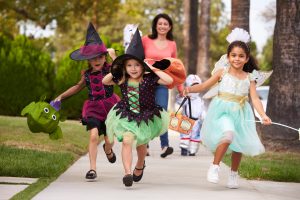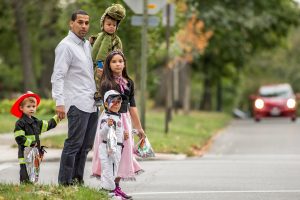
Safe costumes:
- Decorate costumes and bags with reflective tape or stickers and, if possible, choose light colored clothing.
- Masks can obstruct a child’s vision, so choose non-toxic face paint and make-up whenever possible.
- Have children carry glow sticks or flashlights so they can see better, as well as be seen by drivers.
- Check to make sure costumes aren’t too long to prevent tripping.

Safe walking:
- Stay alert. Watch out for cars that are turning or backing up and don’t dart out into the street or cross in between parked cars.
- Walk on sidewalks or paths. If there are no sidewalks, walk facing traffic as far to the left as possible.
- Put electronic devices down and keep heads up and walk, don’t run, across the street.
- It’s best to cross the street safely at corners. Before crossing, look left, right and left again and make eye contact with drivers.

Safe Driving:
- Slow down in residential neighborhoods. Remember that popular trick-or-treating hours are 5:30 to 9:30 p.m.
- Be especially alert and take extra time to look for kids at intersections, on medians and on curbs. Children are excited on Halloween and may move in unpredictable ways.
- Reduce any distractions inside your car, such as talking on the phone or eating, so you can concentrate on the road and your surroundings.
- Be cautious when backing out of driveways and parking spots; expect to see children late at night in areas where you usually wouldn’t.
Be Safe, Be Seen on Halloween
Kids are more than twice as likely to be hit by
a car and killed on Halloween
than on any other day of the year.
No Scary Driving this Halloween.
There’s a lot of information instructing children to be safe during Halloween. However, with pedestrian-vehicle collisions being four times more likely on Halloween, it’s important to highlight some Halloween safety tips for adults. As drivers, we have a responsibility to follow traffic safety advice and help keep children safe on Halloween.

